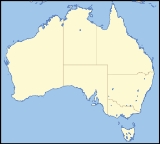
Churchill National Park
Encyclopedia
Churchill is a national park in Victoria
, Australia
, 31 km southeast of Melbourne. Churchill NP is in the suburb of Lysterfield South, which lies between Rowville and Endeavour Hills in the far north of the City Of Casey. It is also near the Monash Freeway
and Stud Road. Churchill National Park has fantastic woodland and lots of fauna.
Churchill is joined onto Lysterfield Park
, and joined, they cover around 16.68 km².
There are tracks throughout Churchill for walking, cycling and jogging. One recommended walking track for a very peaceful walk is Channel Track, surrounded by thick woodland and it runs beside the old aqueduct. The Eastern boundary track is particularly good for cycling and jogging. Bird watching is spectacular at Churchill NP, and one good spot for bird watching is by the dam along the northern boundary track.
The park that is now Churchill national park was once the police corps headquarters for blacktrackers and provided grazing land for the police horses. Many years later it was known as the Police Paddocks. In the 1920s, metropolitan development brought some change to Churchill, which was still known as Police Paddocks. Local stone was dug up for road metal and building material, a water supply channel was cut to Dandenong, and the State Electricity Commission obtained a power line easement. Fire and the clearing of the area took place. In 1941 the area was named Dandenong National Park, later renamed Churchill National Park (after Sir Winston Churchill
) in 1944.
Churchill National Park is famous for its 173 different species of birds, such as the Australian Wood Duck and the Pacific Black Duck. Most mammals are only active at night, so if you arrive early or leave late, you might be lucky enough to see one, such as Echidnas, Wallabies and Kangaroos. Echidnas are also active during the day, searching for ants and grubs in the ground.
The picnic ground at Churchill NP has gas barbecues, a uni-sex toilet and shelter. Picnic grounds are provided on the end of the access road.
Victoria (Australia)
Victoria is the second most populous state in Australia. Geographically the smallest mainland state, Victoria is bordered by New South Wales, South Australia, and Tasmania on Boundary Islet to the north, west and south respectively....
, Australia
Australia
Australia , officially the Commonwealth of Australia, is a country in the Southern Hemisphere comprising the mainland of the Australian continent, the island of Tasmania, and numerous smaller islands in the Indian and Pacific Oceans. It is the world's sixth-largest country by total area...
, 31 km southeast of Melbourne. Churchill NP is in the suburb of Lysterfield South, which lies between Rowville and Endeavour Hills in the far north of the City Of Casey. It is also near the Monash Freeway
Monash Freeway
Monash Freeway is an urban freeway in Victoria, Australia linking Melbourne's CBD to its southeastern suburbs and the Gippsland region. The entire stretch of the Monash Freeway bears the designation...
and Stud Road. Churchill National Park has fantastic woodland and lots of fauna.
Churchill is joined onto Lysterfield Park
Lysterfield Park
Lysterfield Park is a public park in Lysterfield, a suburb to the south-east of Melbourne, Victoria, Australia. It was the venue for mountain biking events of the 2006 Commonwealth Games....
, and joined, they cover around 16.68 km².
There are tracks throughout Churchill for walking, cycling and jogging. One recommended walking track for a very peaceful walk is Channel Track, surrounded by thick woodland and it runs beside the old aqueduct. The Eastern boundary track is particularly good for cycling and jogging. Bird watching is spectacular at Churchill NP, and one good spot for bird watching is by the dam along the northern boundary track.
The park that is now Churchill national park was once the police corps headquarters for blacktrackers and provided grazing land for the police horses. Many years later it was known as the Police Paddocks. In the 1920s, metropolitan development brought some change to Churchill, which was still known as Police Paddocks. Local stone was dug up for road metal and building material, a water supply channel was cut to Dandenong, and the State Electricity Commission obtained a power line easement. Fire and the clearing of the area took place. In 1941 the area was named Dandenong National Park, later renamed Churchill National Park (after Sir Winston Churchill
Winston Churchill
Sir Winston Leonard Spencer-Churchill, was a predominantly Conservative British politician and statesman known for his leadership of the United Kingdom during the Second World War. He is widely regarded as one of the greatest wartime leaders of the century and served as Prime Minister twice...
) in 1944.
Churchill National Park is famous for its 173 different species of birds, such as the Australian Wood Duck and the Pacific Black Duck. Most mammals are only active at night, so if you arrive early or leave late, you might be lucky enough to see one, such as Echidnas, Wallabies and Kangaroos. Echidnas are also active during the day, searching for ants and grubs in the ground.
The picnic ground at Churchill NP has gas barbecues, a uni-sex toilet and shelter. Picnic grounds are provided on the end of the access road.

